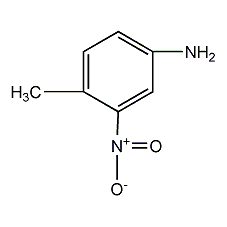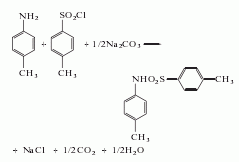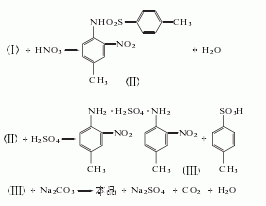
Structural formula
| Business number | 0210 |
|---|---|
| Molecular formula | C7H8N2O2 |
| Molecular weight | 152.15 |
| label |
2-nitro-p-toluidine, 2-nitro-4-toluidine, 4-amino-3-nitrotoluene, red base GL, 2-Nitro-p-toluidine, 4-Amino-3-nitrotoluene, Aromatic nitrogen-containing compounds and their derivatives |
Numbering system
CAS number:89-62-3
MDL number:MFCD00007907
EINECS number:201-924-9
RTECS number:XU8227250
BRN number:879506
PubChem number:24846243
Physical property data
1. Properties: Orange-red flammable crystals, industrial products are orange-red tide materials
2. Density (g/mL, 25/4℃): 1.164
3. Relative vapor density (g/mL, air=1): Not determined
4. Melting point (ºC): 117
5. Boiling point (ºC, normal pressure): Not determined
6. Boiling point (ºC, 5.2kPa): 140℃ (10mmHg)
7. Refractive index: Undetermined
8. Flash point (ºC): 157.2
9. Specific rotation (º): Not determined
10. Autoignition point or ignition temperature (ºC): Undetermined
11. Vapor Pressure (kPa, 25ºC): Undetermined
12. Saturated vapor pressure (kPa, 60ºC): Undetermined
13. Heat of combustion (KJ/mol): Undetermined
p>
14. Critical temperature (ºC): Undetermined
15. Critical pressure (KPa): Undetermined
16. Oil-water (octanol/water) partition coefficient The logarithmic value of p>
19. Solubility: Easily soluble in hot ethanol, soluble in ether, slightly soluble in carbon disulfide.
Toxicological data
This product is toxic. See o-nitroaniline.
Ecological data
None
Molecular structure data
1. Molar refractive index: 41.85
2. Molar volume (cm3/mol): 119.8
3. Isotonic specific volume (90.2K ): 326.2
4. TableSurface tension (dyne/cm): 54.9
5. Polarizability (10-24cm3): 16.59
Compute chemical data
1. Reference value for hydrophobic parameter calculation (XlogP): None
2. Number of hydrogen bond donors: 1
3. Number of hydrogen bond acceptors: 3
4. Number of rotatable chemical bonds: 0
5. Number of tautomers: none
6. Topological molecule polar surface area 71.8
7. Number of heavy atoms: 11
8. Surface charge: 0
9. Complexity: 155
10. Number of isotope atoms: 0
11. Determine the number of atomic stereocenters: 0
12. Uncertain number of atomic stereocenters: 0
13. Determine the number of chemical bond stereocenters: 0
14. Number of uncertain chemical bond stereocenters: 0
15. Number of covalent bond units: 1
Properties and stability
This product is toxic. See o-nitroaniline.
Storage method
This product should be stored in a sealed, cool, dry place.
Packaged in iron drums lined with plastic bags. 50kg or 100kg per barrel. Store in a dry, ventilated place, away from sunlight, heat and moisture. Store and transport according to regulations on toxic and dangerous goods.
Synthesis method
1. Using p-toluidine and p-toluenesulfonyl chloride as raw materials, it is obtained through condensation, nitration, hydrolysis and neutralization. The total yield of this method is about 80%. Industrial product 2-nitro-p-toluidine should comply with HG2-376-80. Raw material consumption quota: p-toluidine (100%) 812kg/t, chlorobenzene 300kg/t, p-toluenesulfonyl chloride (or benzenesulfonyl chloride) (100%) 1300kg/t, caustic soda (100%) 634kg/t, sulfuric acid ( 100%) 2100kg/t, nitric acid (98%) 552kg/t, hydrochloric acid (31%) 93kg/t, soda ash (98%) 580kg/t, sodium nitrite (98%) 10kg/t, sodium bisulfite ( Industry) 5kg/t.
2. Obtained from nitration and hydrolysis of p-methylacetanilide. Cool the sulfuric acid with a relative density of 1.82, add p-methylacetanilide, and add nitric acid with a relative density of 1.4 dropwise at 25-35°C. Complete the addition in about 3 hours, stir for 2 hours, put it into ice water to precipitate crystals, filter, and wash with water to obtain o-Nitro-p-methylacetanilide. Add it to a sodium hydroxide solution at 80-90°C, reflux for 3 hours, cool to room temperature, filter out the crystals, wash away the oil with ethanol, and then recrystallize with ethanol to obtain the finished product. Raw material consumption quota: p-toluidine (99%) 793kg/t, p-toluenesulfonyl chloride (97%) 1300kg/t, chlorobenzene 292kg/t, soda ash 1076kg/t, nitric acid 494kg/t, sulfuric acid 3218kg/t.


Purpose
This product is an important intermediate for azo dyes and the color base (red base GL) of ice dyes. Used for dyeing and printing of cotton fiber and viscose fiber. It can also be used to produce toluidine red, toluidine purple red, Hansa yellow G and other organic pigments. Synthetic organic pigments Toluidine Red, Toluidine Purple Red, Pigment Maroon Red, Hansa Yellow G, Hansa Yellow 10G, Hansa Yellow A, Pigment Yellow GRL, Pigment Orange 6, Macromolecular Yellow GRL. Disperse dyes can also be synthesized, mainly including disperse fluorescent yellow I, disperse yellow 8, disperse yellow H3GL, green disperse dyes, mordant dyes, etc. Also used in the production of inks and coatings.

 微信扫一扫打赏
微信扫一扫打赏

